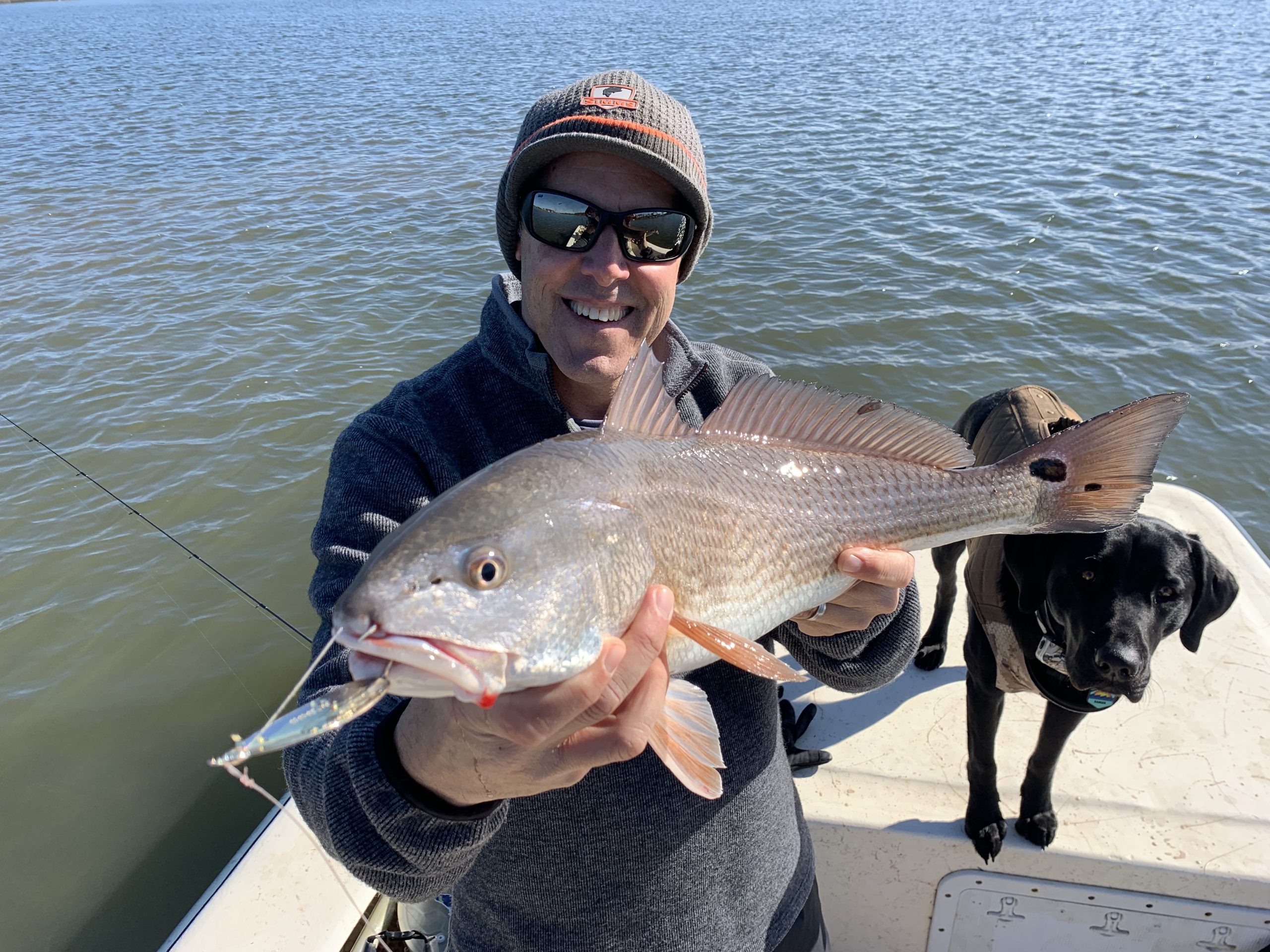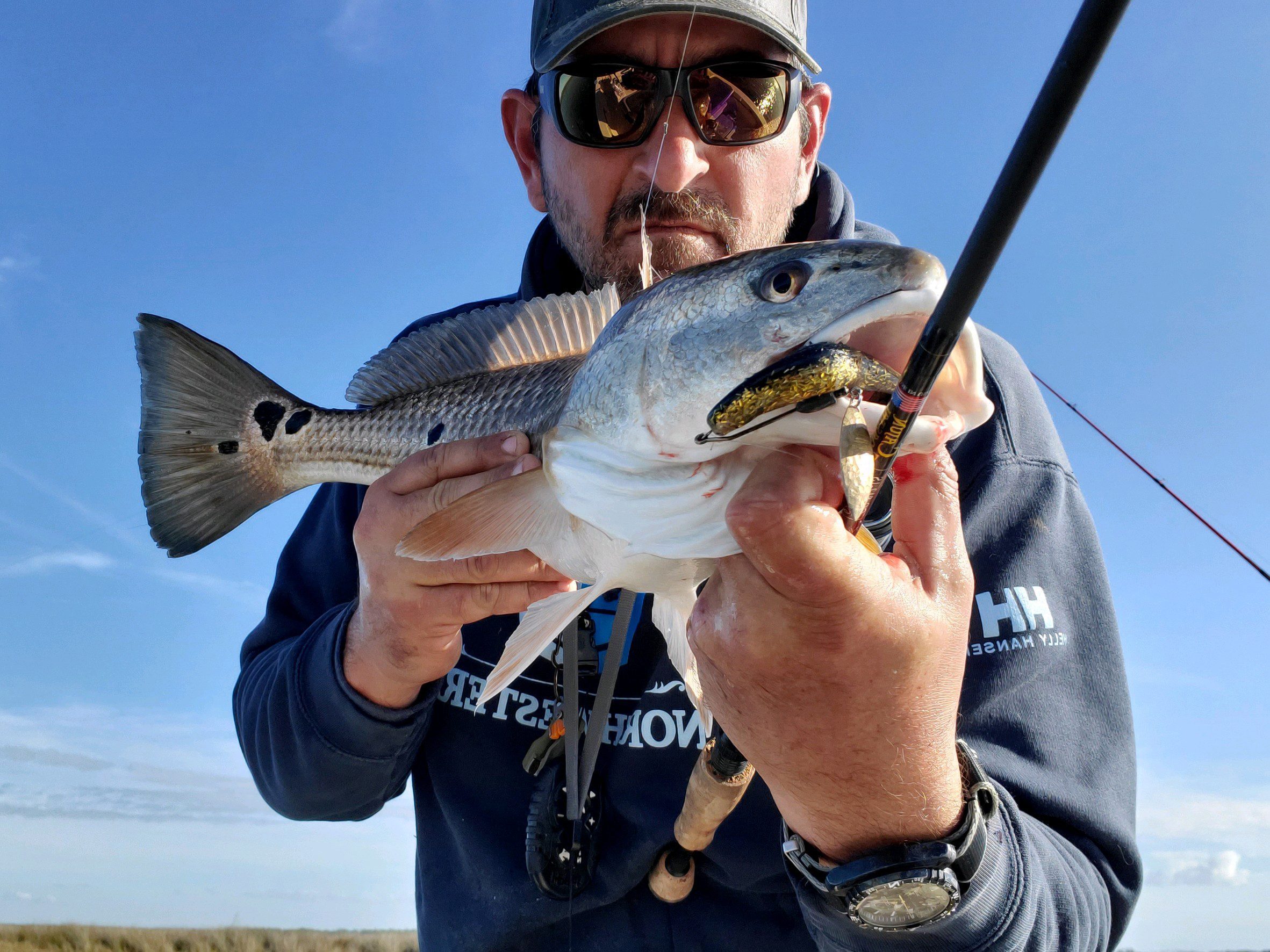Tidelines – March 2022
Capt. Joe Tunstall, of Carolina Traditions Guide Co. out of Beaufort, had given me the leisurely meeting time of 9:00 am for our early February red drum trip. There was no need to meet earlier, he explained, as our plan was to go sight casting, and we would need the sun to come up a bit to provide some light to penetrate the water and to have a chance for the winter air and water to perhaps warm a bit.
I tried not to overthink the cold temperature on my drive up to the Straights Landing public boat ramp, seeing the outside temperature displayed on my rearview mirror move around from 28-37 degrees during the drive. It settled on 34 degrees as I pulled in, parked, and put on all my layers.

Gary Hurley, of Fisherman’s Post, with an upper-slot redfish caught on a gold spoon while sight casting in a bay off Core Sound. He was fishing with Capt. Joe Tunstall of Carolina Traditions Guide Co. out of Beaufort.
This trip with Joe served several purposes: (1) I knew I would need a Tidelines article for the March issue, and my busy schedule hosting fishing schools in February wouldn’t lighten until after that issue went to print; (2) It was just a few days before the Morehead Saltwater Fishing School, and I had a couple of errands to run in Morehead and Atlantic Beach anyways; and (3) I just needed a break from work, and I knew from a previous trip with Joe that a day on the water would mean catching fish and catching up with a good friend—two pastimes good for anyone’s soul.
Joe pulled up to our first spot, a shallow flat that he hadn’t been to in a few days because of inclement weather, but a spot where he had caught fish in the days before. He handed me a rod with a gold spoon, and I headed for the bow. We were in water 2-3’ deep, and the trolling motor soon had us near a large school of winter reds.
We saw one or two “scouts” first, and they moved away but not in a panic. Then we saw many more fish move further up ahead. I quickly threw the gold spoon, and Joe let fly a soft plastic. Both of us brought our artificials right through the heart of the school, but neither of us came tight.
We continued to see fish and continued to cast to fish, but no bites. Whether it was too early or not warm enough, they just didn’t want it. That’s the only theory we could come up with.
Joe moved the boat away from the school and towards the back of the creek where he had seen another school residing earlier in the week. The school was where he thought they would be; however, this school was smaller, and they, too, didn’t want anything we threw at them.
No new theory, so it was time to try a new location.
We headed further up Core Sound to a bay with good cover. Like our first spot, Joe came off plane, deployed the trolling motor, handed me a gold spoon, grabbed a soft plastic for himself, and sent me to the bow. Then he pointed to an area up ahead where he predicted we would get our first bite.
The spot he pointed to was past the first set of docks, and while there weren’t wakes or obvious fish movements, the water did seem to have a subtle agitation. Joe was able to spot the ever-so-slight movement for several reasons. In addition to extensive time on the water and his drive to constantly work on the craft of fishing, Joe stands about 6’5” tall, and that’s without standing on the “osprey nest,” his Yeti 65 that sits atop of the seat in front of the console.
The fish were right where he predicted, and once again we saw a couple of outside fish move off into the distance, and then several more fish move with them. These fish were a little bit more unsettled than our first school, so I decided to bomb my gold spoon as far as I could and way beyond where the school was headed.
Wanting every opportunity to be successful, I made sure to follow Joe’s gold spoon instructions. Unlike others I’ve fished with who say to cast out and bring in with a steady retrieve, Joe likes a couple of cranks, a pause, a couple more cranks, a pause, and so on.
My first cast came back without generating any attention, so I threw it back out but not in the direction of where I had seen the fish heading. I was hoping that there were still fish off in the distance from where we had first found them, fish that hadn’t picked up to move, and that was where the spoon went.
A couple of cranks, a pause, a couple more cranks, a pause, but no bites. I turned to Joe wondering. He had no immediate answer, so I turned back to continue the retrieve, and that’s when the bite happened.
The bite wasn’t a hard bite, but it was clearly a bite. There also wasn’t a long run when the red felt the hook, nor was there a second run when the red saw the boat, but despite clearly being cold and in winter mode, our redfish pulled drag and covered some water.

Capt. Joe Tunstall, of Carolina Traditions Guide Co., with a red drum that hit a soft plastic spinner bait while sight casting in 2-3′ of water.
Shallow water redfishing, especially in clean and clear winter waters, means visual pleasure, and while I didn’t see my fish take the spoon, the red showed itself the second it turned with the hook. And with only 2-3’ of water, I was able to watch every turn, every run, and every splash until the fish came over the gunnel.
Fishing is often theories with no definitive answers, and my theory was that it was the extended pause of turning to Joe. The redfish had just needed more pause than I had been giving, and once there was a bigger pause, it took the spoon.
But again, that’s just a theory.
If the question is who to book for an early to late spring sight casting trip for redfish in the Beaufort/Morehead area, though, then I do have a definitive answer and not a theory. Call Capt. Joe Tunstall, of Carolina Traditions Guide Co., at (252) 342-2000, or visit him online at www.fishcarolinatraditions.com.
And if you want another theory, then Google first moon landing, JFK, Princess Diana, or the nearly extinct red snapper.





